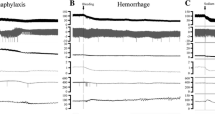Abstract
The case report presents evidence for the spinal origin of the marked hypertensive reponses to noxious stimuli that may occur in organ donors who fulfill the commonly accepted criteria of brain death. Cardiovascular spinal reflex activity does not invalidate these criteria. For the first time, the catecholamine plasma concentrations have been determined during spinal pressor reflex activity. Circulating epinephrine increased more markedly than norepinephrine in both cases, rising to 4.7 and 44 times the baseline concentration respectively. The relation between plasma norpinephrine and epinephrine suggests involvement of the adrenal medulla in the reflex arc. The literature on spinal hemodynamic reflexes is reviewed.
Similar content being viewed by others
References
Ivan LP (1973) Spinal reflexes in cerebral death. Neurology 23:650–652
Jørgensen EO (1973) Spinal man after brain death. Acta Neurochir (Wien) 28:259–273
Turmel A, Roux A, Bojanowski MW (1991) Spinal man after declaration of brain death. Neurosurgery 28:298–301
Wetzel RC, Setzer N, Stiff JL, Rogers MC (1985) Hemodynamic responses in brain dead organ donor patients. Anesth Analg 64:125–128
Larson MD (1985) Surgically induced hypertension in brain dead patients. Anesth Analg: 1030
Conci F, Procacaccio F, Arosio M, Boselli L (1986) Viscero-somatic and viscero-visceral reflexes in brain death. J Neurol Neurosurg Psychiatry 49:695–698
Wissenschaftlicher Beirat der Bundesärztekammer (1986) Kriterien des Hirntodes. Dtsch Ärztebl 43:2940–2946
Zimmermann J, Dennhardt R, Gramm H-J (1991) Measurement of plasma catecholamines by high-performance liquid chromatography with electrochemical detection in intensive care patients after dobutamine infusion. J Chromatogr 567:240–247
Dowman CBB, McSwiney BA (1946) Reflexes elicited by visceral stimulation in the acute spinal animal. J Physiol (Lond) 105:80–94
Naftchi NE, Wooten GF, Lowman EW, Axelrod J (1974) Relationship between serum dopamine-ß-hydroxylase activity, catecholamine metabolism, and hemodynamic changes during paroxysmal hypertension in quadriplegia. Circ Res 35:850–861
Nishimura N and Miyata Y (1984) Cardiovascular changes in the terminal stage of disease. Resuscitation 12:175–180
Author information
Authors and Affiliations
Rights and permissions
About this article
Cite this article
Gramm, H.J., Zimmermann, J., Meinhold, H. et al. Hemodynamic responses to noxious stimuli in brain-dead organ donors. Intensive Care Med 18, 493–495 (1992). https://doi.org/10.1007/BF01708589
Received:
Accepted:
Issue Date:
DOI: https://doi.org/10.1007/BF01708589




